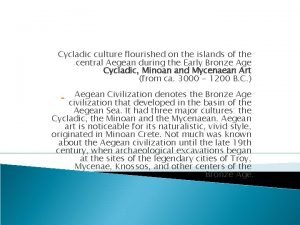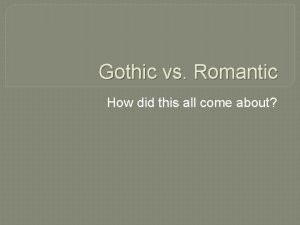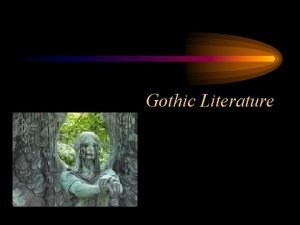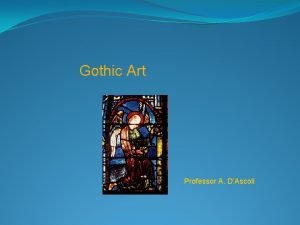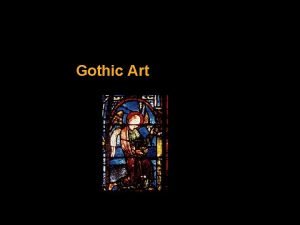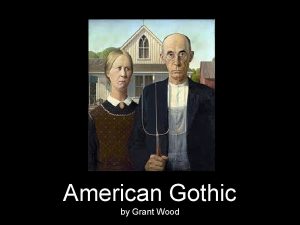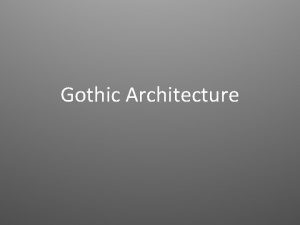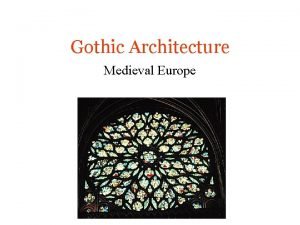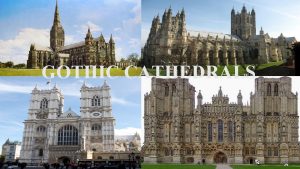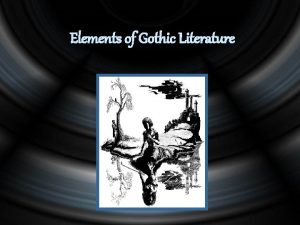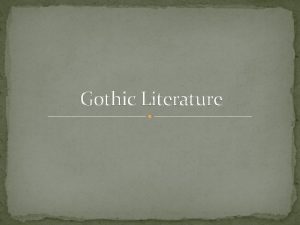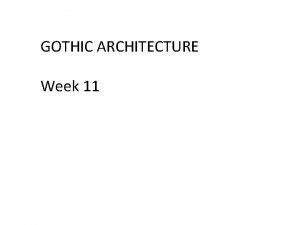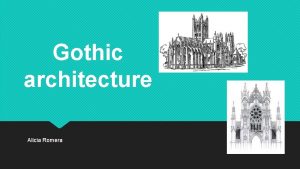ENGLISH GOTHIC ARCHITECTURE Origin Gothic architecture flourished in










- Slides: 10

ENGLISH GOTHIC ARCHITECTURE

Origin Gothic architecture flourished in England from about 1180 until about 1520. It found its inception in France, specifically in Burgundy and Provence as a development from earlier styles of Western Christian architecture (labeled “Classical” or “Romanesque”). The term “Gothic” was applied to this architecture style and culture by those who invented it to mean barbarous due to its status as non-classical.

Characteristic elements • • This architecture is defined by a lot of elements: pointed arches; vaulted roofs; flying buttresses; pinnacles; ribs; spires; large and lancet windows. Several of them had derived from Romanesque architecture.

Fan vaults are vaults, peculiar to English Gothic architecture, in which the ribs are all of equal curvature and rotated at equal distances around a central axis, forming the fanned shape which gives them this characteristic name. They developed in Gloucester between 1351 and 1377.

Canterbury Cathedral in Canterbury, Kent, is the oldest and most famous Gothic cathedral in England. It is the seat of the Archbishop of Canterbury, leader of the Church of England symbolic leader of the worldwide Anglican Communion. Founded in 597, the cathedral was completely rebuilt from 1070 to 1077; then it was enlarged at the beginning of the twelfth century and in 1174 following a fire it was rebuilt again in the Gothic style, with significant extensions to accommodate the flow of pilgrims visiting the shrine of St. Thomas à Becket.

Exterior The exterior of Canterbury Cathedral impresses by its size, but also rewards closer attention to its details. Viewed directly from the south, the abrupt change from Romanesque to Gothic is clearly evident: on the right part there are round arches, blind arcades and rough surfaces; on the left instead abundant are the pointed arches and the pinnacles. Decorating the Romanesque exterior are intertwined blind arches embellished with decoratively carved columns and figurative capitals.

Interior The interior is characterized by a Latin cross plan of three naves. They terminate at a great Gothic choir screen (a. k. a. rood screen) at the top of a wide stairway. East of the choir there’s the large Trinity Chapel, a level higher than the rest of the interior and surrounded by an ambulatory; it is reached by stone stairs on either side while the floor, near the west end, has a set of interesting inlaid marble roundels. This chapel was built specifically for the shrine of St. Thomas à Becket. The massive crypt beneath the east end of the cathedral is one of the most fascinating parts.

Stained glass windows The stained glass windows (or vitrails) enrich Canterbury Cathedral. They portray important moments about St. Thomas à Becket’s life but also biblical episodes. Their function in Medieval Times was to show the people, that didn’t know Latin and consequently didn’t understand religious celebrations, the most important elements of Christianity. Their extreme vivid and bright colors attracted people’s attention on the scenes they represented. These particular windows developed in the Roman Empire and evolved during the centuries arriving in England just between XII and XIII centuries.

Realized by: Samuele Bilello Antonino Provenzano Vito Speciale

Thank you for the attention
 The jazz style called swing flourished in america from
The jazz style called swing flourished in america from The indus valley civilization flourished around
The indus valley civilization flourished around Period when mycenaean culture flourished
Period when mycenaean culture flourished American gothic examples
American gothic examples Diffusion of english language
Diffusion of english language Romantic vs gothic
Romantic vs gothic Gothic themes in literature
Gothic themes in literature Features of the gothic
Features of the gothic Radiating chapels
Radiating chapels Gothic vs romanticism
Gothic vs romanticism American gothic architecture
American gothic architecture


